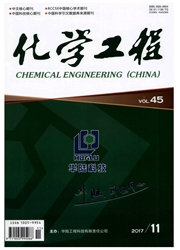

 中文摘要:
中文摘要:
主要研究了甲醛、乙醛和苯在有机硅烷KH560和1706改性活性炭(AC)表面的脱附活化能,并通过透过曲线实验测定了不同湿度对三者在改性活性炭上吸附的影响,最后用光电子能谱(XPS)分析材料表面的亲水基团和憎水基团比例的变化。结果表明,采用有机硅烷改性活性炭可提高材料的憎水性,在较高湿度下(RH〉60%),三者在未改性活性炭固定床穿透时间减少得最多,1706/AC固定床次之,KH560/AC固定床最小;程序升温脱附(TPD)实验表明,用有机硅烷改性活性炭可以削弱水和活性炭表面的结合力,增强与甲醛、乙醛和苯的结合力。通过XPS分析,与未改性活性炭相比,经有机硅烷改性的活性炭,其憎水性得到提高。
 英文摘要:
英文摘要:
The activation energy of desorption for formaldehyde,acetaldehyde and benzene in the oil fume on the activated carbons(AC) modified with organosilane KH560 and 1706 was studied.The effects of humidity on the adsorption of formaldehyde,acetaldehyde and benzene on modified activated carbons were investigated with the breakthrough curve experiment.The proportion changes of hydrophilic groups to hydrophobic groups on the material surface were analyzed with XPS.The results show that the hydrophobic property of the modified activated carbons is improved.The breakthrough time of formaldehyde,acetaldehyde and benzene in the packed beds of the KH560/AC is the longest,then the 1706/AC,and the unmodified activated carbon is the shortest under the conditions of higher relative humidity(RH60%).Temperature-programmed desorption(TPD) experiments show that using organosilane compounds to modify surfaces of the activated carbon can enhance the interaction between volatile organic compounds in the oil fume and the surfaces.
 同期刊论文项目
同期刊论文项目
 同项目期刊论文
同项目期刊论文
 期刊信息
期刊信息
